Hydrological Modeling of Aquifer’s Recharge and Discharge Potential by Coupling WetSpass and MODFLOW for the Chaj Doab, Pakistan
Abstract
1. Introduction
2. Materials and Methods
2.1. Study Area
2.1.1. Conceptual Modeling Approach
2.1.2. Climatic Data
2.1.3. Lithology
2.1.4. Topography
2.2. Groundwater Data
2.3. Groundwater Recharge and Evapotranspiration
2.4. Groundwater Flow Model Setup
2.5. Coupling of Surface Water Model and Groundwater Flow Model
2.6. Calibration, Validation, and Sensitivity Analyses
3. Results
3.1. Groundwater Flow Model Budget
3.2. Simulated Scenarios
3.2.1. Scenarios
3.2.2. Model Uncertainty
4. Conclusions
Author Contributions
Funding
Institutional Review Board Statement
Informed Consent Statement
Data Availability Statement
Acknowledgments
Conflicts of Interest
References
- Kijne, J.W.; Kuper, M. Salinity and sodicity in Pakistan’s Punjab: A threat to sustainability of irrigated agriculture? Int. J. Water Resour. Dev. 1995, 11, 73–86. [Google Scholar] [CrossRef]
- Shah, T. Grundwater Governance and Irrigated Agriculture; Tech. Background Papers No. 19; Global Water Partnership Technical Committee (TEC): Stockholm, Sweden, 2014; pp. 1–69. [Google Scholar]
- Shakoor, A.; Arshad, M.; Bakhsh, A.; Ahmad, R. GIS based assessment and delineation of groundwater quality zones and its impact on agricultural productivity. Pak. J. Agric. Sci. 2015, 52, 837–843. [Google Scholar]
- Qureshi, A. Groundwater Management in Pakistan: The Question of Balance. 2021. Available online: https://pecongress.org.pk/images/upload/books/10-Asad%20Sarwar%20Qureshi.pdf (accessed on 24 October 2020).
- Qureshi, A.S.; Mccornick, P.G.; Sarwar, A.; Sharma, B.R. Challenges and prospects of sustainable groundwater management in the Indus Basin, Pakistan. Water Resour. Manag. 2010, 24, 1551–1569. [Google Scholar] [CrossRef]
- Zakir-Hassan, G.; Hassan, F.R.; Shabir, G.; Rafique, H. Impact of Floods on Groundwater—A Case Study of Chaj Doab in Indus Basin of Pakistan. Int. J. Food Sci. Agric. 2021, 5, 639–653. [Google Scholar] [CrossRef]
- Ahmad, M.-U.-D.; Bastiaanssen, W.G.M.; Feddes, R.A. A new technique to estimated groundwater use at irrigated areas by combining remote sensing and water balance approaches Rachna Doab, Pakistan. Hydrol. J. 2005, 13, 653–664. [Google Scholar] [CrossRef]
- PPSDGP. Punjab Private Sector Groundwater Development Project Consultants; Final Report; PPSGDP: Islamabad, Pakistan, 2000. [Google Scholar]
- Adane, G.W. Groundwater Modeling and Optimization of Irrigation Water Use Efficiency to Sustain Irrigation in Kobo Valley, Ethiopia. Master’s Thesis, UNESCO-IHE, Delft, The Netherlands, 2014. [Google Scholar]
- Gebreyohannes, T.; Smedt, F.D.; Walraevens, K.; Gebresilassie, S.; Hussien, A.; Hagos, M.; Amare, K.; Deckers, A.; Gebrehiwot, K. Regional groundwater flow modeling of the Geba basin, northern Ethiopia. Hydrogeol. J. 2017, 25, 639–655. [Google Scholar] [CrossRef]
- Durand, V.; Léonardi, V.; Marsily, G.D.; Lachassagne, P. Quantification of the specific yield in a two-layer hard-rock aquifer model. J. Hydrol. 2017, 551, 328–339. [Google Scholar] [CrossRef][Green Version]
- Salem, A.; Dezső, J.; El-Rawy, M.; Loczy, D. Water management and retention opportunities along the Hungarian section of the Drava River. In Proceedings of the 2nd Euro-Mediterranean Conference for Environmental Integration (EMCEI), Sousse, Tunisia, 10–13 October 2019. [Google Scholar]
- Asoka, A.; Gleeson, T.; Wada, Y.; Mishra, V. Relative contribution of monsoon precipitation and pumping to changes in groundwater storage in India. Nat. Geosci. 2017, 10, 109–117. [Google Scholar] [CrossRef]
- Kambale, J.B.; Singh, D.K.; Sarangi, A. Impact of climate change on groundwater recharge in a semi-arid region of northern India. Appl. Ecol. Environ. Res. 2017, 15, 335–362. [Google Scholar] [CrossRef]
- Abu-el-Shar, W.A.; Hatamleh, R.I. Using MODFLOW and MT3D groundwater flow and transport models as a management tool for the Azraq groundwater system. Jordan J. Civil Eng. 2007, 1, 153–172. [Google Scholar]
- Moeck, C.; Affolter, A.; Radny, D.; Auckenthaler, A.; Huggenberger, P.; Schirmer, M. Improved water resource management using three dimensional groundwater modelling for a highly complex environmental. In Proceedings of the EGU General Assembly Conference Abstracts, Vienna, Austria, 23–28 April 2017; Volume 19, p. 19056. [Google Scholar]
- Galitskaya, I.V.; Mohan, K.R.; Krishna, A.K.; Batrak, G.I.; Eremina, O.N.; Putilina, V.S.; Yuganova, I. Assessment of soil and groundwater contamination by heavy metals and metalloids in Russian and Indian megacities. Procedia Earth Planet Sci. 2017, 17, 674–681. [Google Scholar] [CrossRef]
- Abdullah, T.; Morteza, K. Groundwater modeling by MODFLOW model In Toyserkan aquifer and evaluation of hydrogeo-logical state under present and future conditions. Water Eng. 2017, 9, 45–60. [Google Scholar]
- Kori, S.M.; Qureshi, A.L.; Lashari, B.K.; Memon, N.A. Optimum strategies of groundwater pumping regime under scavanger tubewells in lower Indus basin, Sindh, Pakistan. Inter. Water Tech. J. 2013, 3, 138–145. [Google Scholar]
- Dezső, J.; Salem, A.; Lóczy, D.; Slowik, M.; Dávid, P. Randomly layered fluvial sediments influenced groundwater-surface water interaction. In Proceedings of the 17th International Multidisciplinary Scientific GeoConference SGEM 2017, Vienna, Austria, 27 June–6 July 2017; Volume 17, pp. 331–338. [Google Scholar]
- Schwartz, F.W.; Gallup, D.N. Some factors controlling the major ion chemistry of small lakes: Examples from the prairie parkland of Canada. Hydrobiologia 1978, 58, 65–81. [Google Scholar] [CrossRef]
- Stauffer, R.E. Effects of citrus agriculture on ridge lakes in Central Florida. Water Air Soil Pollut. 1991, 59, 125–144. [Google Scholar] [CrossRef]
- Nakayama, T.; Watanabe, M. Missing role of groundwater in water and nutrient cycles in the shallow eutrophic lake Kasu-migaura, Japan. Hydrol. Process. 2008, 22, 1150–1172. [Google Scholar] [CrossRef]
- Salem, A.; Dezso, J.; Lóczy, D.; El-Rawy, M.; Słowik, M. Modeling surface water-groundwater interaction in an oxbow of the Drava floodplain. In Proceedings of the 13th International Conference on Hydroinformatics (HIC 2018), Palermo, Italy, 1–6 July 2018; Volume 3, pp. 1832–1840. [Google Scholar]
- Dezső, J.; Lóczy, D.; Salem, A.; Gábor, N. Floodplain connectivity. In The Drava River: Environmental Problems and Solutions; Springer Science + Media: Cham, Switzerland, 2019; pp. 215–230. [Google Scholar]
- Rahmawati, N.; Vuillaume, J.F.; Purnama, I.L.S. Salt intrusion in Coastal and Lowland areas of Semarang City. J. Hydrol. 2013, 494, 146–159. [Google Scholar] [CrossRef]
- Lalehzari, R.; Tabatabaei, S.H.; Kholghi, M. Hydrodynamic coefficients estimation and aquifer simulation using PMWIN model. In Proceedings of the Fourteenth International Water Technology Conference, Cairo, Egypt, 21–23 March 2010; pp. 925–939. [Google Scholar]
- Batelaan, O.; Smedt, F.D. WetSpass: A flexible, GIS based, distributed recharge methodology for regional groundwater modelling. In Impact of Human Activity on Groundwater Dynamics; Gehrels, H., Peters, J., Leibundgut, C., Eds.; International Association of Hydrological Sciences: Wallingford, UK, 2001; pp. 11–17. [Google Scholar]
- Rwanga, S.S. A review on groundwater recharge estimation using Wetspass model. In Proceedings of the International Conference on Civil and Environmental Engineering, (CEE), Johannesburg, South Africa, 27–28 November 2013. [Google Scholar]
- GhouilI, N.; Horriche, F.J.; Zammouri, M.; Benabdallah, S.; Boutheina, F. Coupling WetSpass and MODFLOW for groundwater recharge assessment: Case study of the Takelsa multilayer aquifer, northeastern Tunisia. Geosci. J. 2017, 21, 791–805. [Google Scholar] [CrossRef]
- Salem, A.; Dezso, J.; El-Rawy, M.; Loczy, D. Hydrological Modeling to Assess the Efficiency of Groundwater Replenishment through Natural Reservoirs in the Hungarian Drava River Floodplain. Water 2020, 12, 250. [Google Scholar] [CrossRef]
- Ashraf, A.; Ahmad, Z. Regional groundwater flow modelling of Upper Chaj Doab of Indus Basin, Pakistan using finite ele-ment model (Feflow) and geoinformatics. Geophys. J. Int. 2008, 173, 17–24. [Google Scholar]
- WASID. Analysis of Aquifer Test the Punjab Region, West Pakistan Water and Soil Investigation Division; Water and Power Authority: Lahore, Pakistan, 1964. [Google Scholar]
- Aslam, M.; Salem, A.; Singh, V.P.; Arshad, M. Estimation of Spatial and Temporal Groundwater Balance Components in Khadir Canal Sub-Division, Chaj Doab, Pakistan. Hydrology 2021, 8, 178. [Google Scholar] [CrossRef]
- Abdollahi, K.; Bashir, I.; Verbeiren, B.; Harouna, M.R.; Van Griensven, A.; Huysmans, M.; Batelaan, O. A distributed monthly water balance model: Formulation and application on Black Volta Basin. Environ. Earth Sci. 2017, 76, 198. [Google Scholar] [CrossRef]
- Abu-Saleem, A.; Al-Zubi, Y.; Rimawi, O.; Al-Zubi, J.; Alouran, N. Estimation of Water Balance Components in the Hasa Basin with GIS based WetSpass Model. J. Agron. 2010, 9, 119–125. [Google Scholar] [CrossRef]
- Gebreyohannes, T.; De Smedt, F.; Walraevens, K.; Gebresilassie, S.; Hussien, A.; Hagos, M.; Amare, K.; Deckers, J.; Gebre-hiwot, K. Application of a spatially distributed water balance model for assessing surface water and groundwater resources in the Geba basin, Tigray, Ethiopia. J. Hydrol. 2013, 499, 110–123. [Google Scholar] [CrossRef]
- Armanuos, A.M.; Negm, A.; Yoshimura, C.; Valeriano, O.C.S. Application of WetSpass model to estimate groundwater re-charge variability in the Nile Delta aquifer. Arab. J. Geosci. 2016, 9, 553. [Google Scholar] [CrossRef]
- Salem, A.; Dezso, J.; Mustafa, E.R. Assessment of Groundwater Recharge, Evaporation, and Runoff in the Drava Basin in Hungary with the WetSpass Model. Hydrology 2019, 6, 23. [Google Scholar] [CrossRef]
- Salem, A.; Dezső, J.; El-Rawy, M.; Loczy, D.; Halmai, Á. Estimation of groundwater recharge distribution using Gis based WetSpass model in the Cun-Szaporca oxbow, Hungary. In Proceedings of the 19th International Multidisciplinary Scientific GeoConference SGEM 2019, Albena, Bulgaria, 28 June–7 July 2019; Volume 19, pp. 169–176. [Google Scholar]
- Niswonger, R.G.; Panday, S.; Ibaraki, M. MODFLOW-NWT, A Newton Formulation for MODFLOW-2005; U.S. Geological Survey: Reston, VA, USA, 2011.
- Winston, R.B. ModelMuse-A Graphical User Interface for MODFLOW-2005 and PHAST: US Geological Survey Techniques and Methods 6-A29; U.S. Geological Survey: Reston, VA, USA, 2009.
- McDonald, M.G.; Harbaugh, A.W. A Modular Three-Dimensional Finite Difference Groundwater Flow Model; USGS Techniques of water Resources Investigation Report, book 6; U.S. G.P.O: Washington, DC, USA, 1988; Chapter A1; p. 586.
- Jehangir, W.A.; Qureshi, A.S.; Ali, N. Conjunctive Water Management in the Rechna Doab: An Overview of Resources and Issues; Working Paper 48; International Water Management Institute: Lahore, Pakistan, 2002; Volume 13, pp. 1–65. [Google Scholar]
- Ahmad, M.D. Estimation of Net Groundwater Use in Irrigated River Basins Using Geo-Information Techniques: A Case Study in Rechna Doab, Pakistan. Ph.D. Thesis, Wageningen University, Wageningen, The Netherlands, 2002. [Google Scholar]
- Arshad, M. Contribution of Irrigation Conveyance System Components to the Recharge Potential in Rechna Doab under Lined and Unlined Options. Ph.D. Thesis, Faculty of Agricultural Engineering and Technology, University of Agriculture, Faisalabad, Pakistan, 2004. [Google Scholar]
- Poeter, E.; Hill, E.; Banta, M.C. UCODE_2005 and Six Other Computer Codes for Universal Sensitivity Analysis, Calibration, and Uncertainty Evaluation; U.S. Geological Survey Techniques and Methods 6–A11; USGS: Reston, VA, USA, 2005.
- Banta, E.R. ModelMate—A Graphical User Interface for Model Analysis; U.S. Geological Survey: Reston, VA, USA, 2011; p. 26.
- Dumler, T.J.; Rogers, D.H.; O’brien, D.M. Irrigation Capital Requirements and Energy Costs; Agricultural Experiment Station and Cooperative Extension Service, Kansas State University: Manhattan, KS, USA, 2007. [Google Scholar]


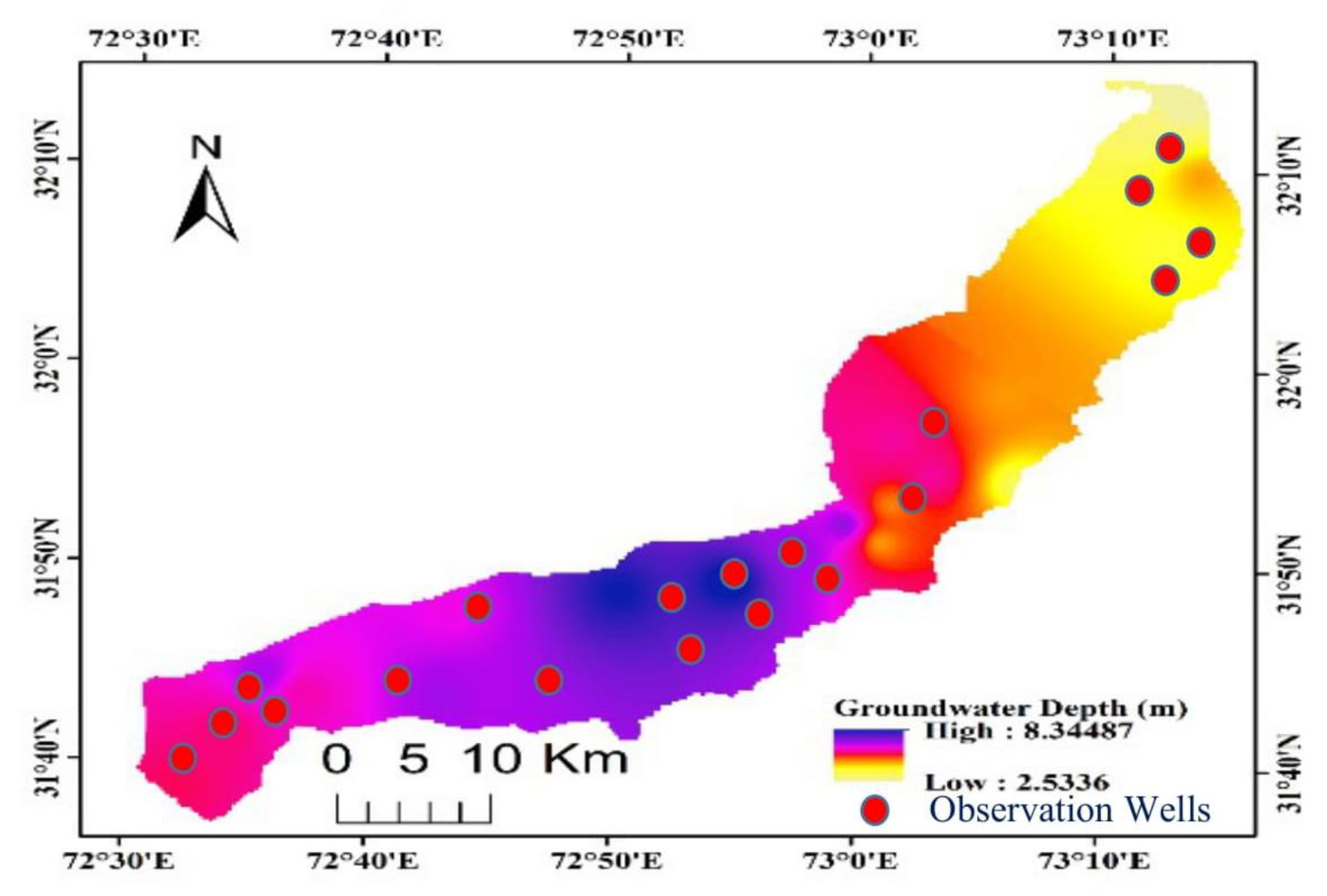



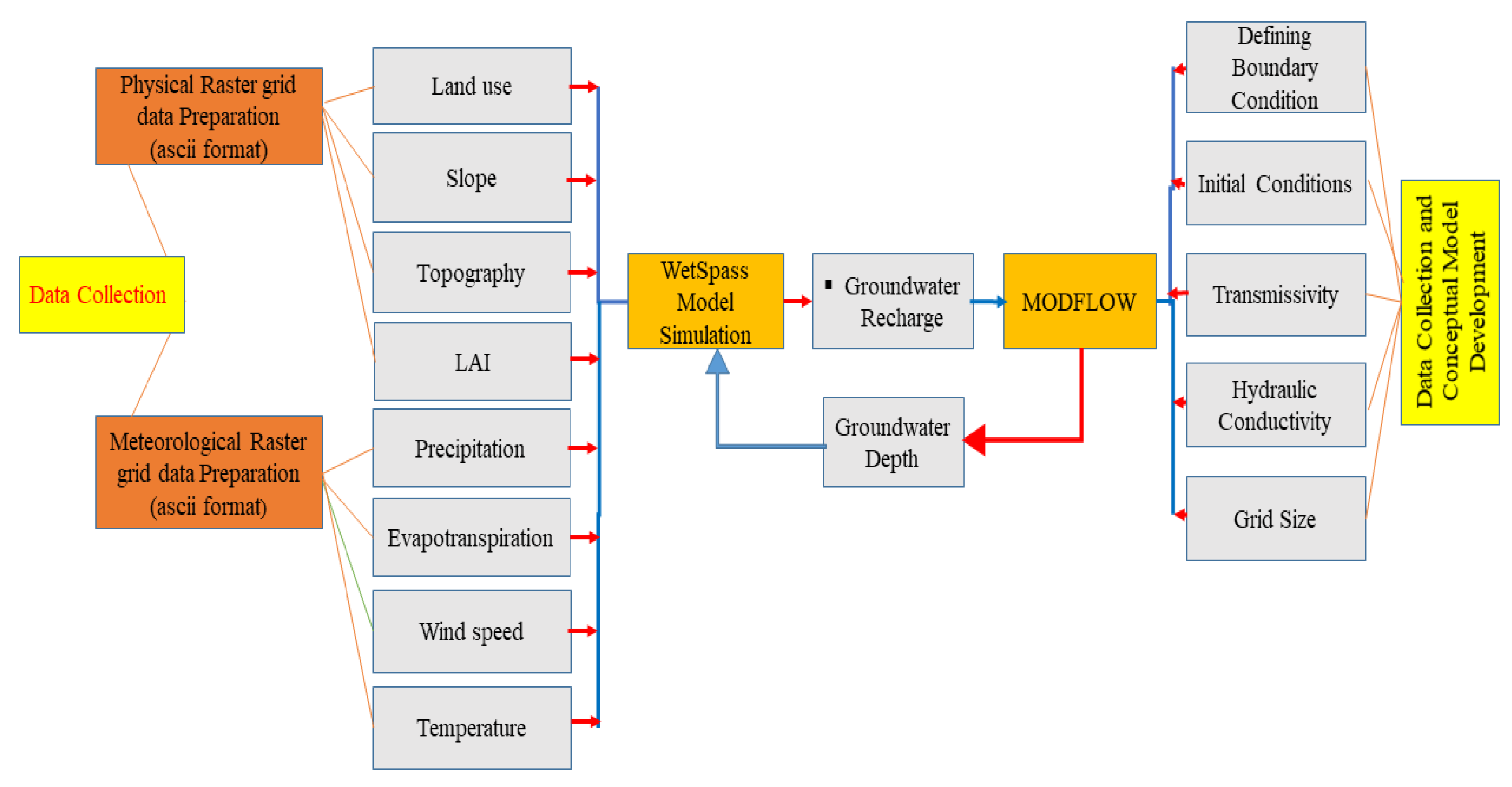

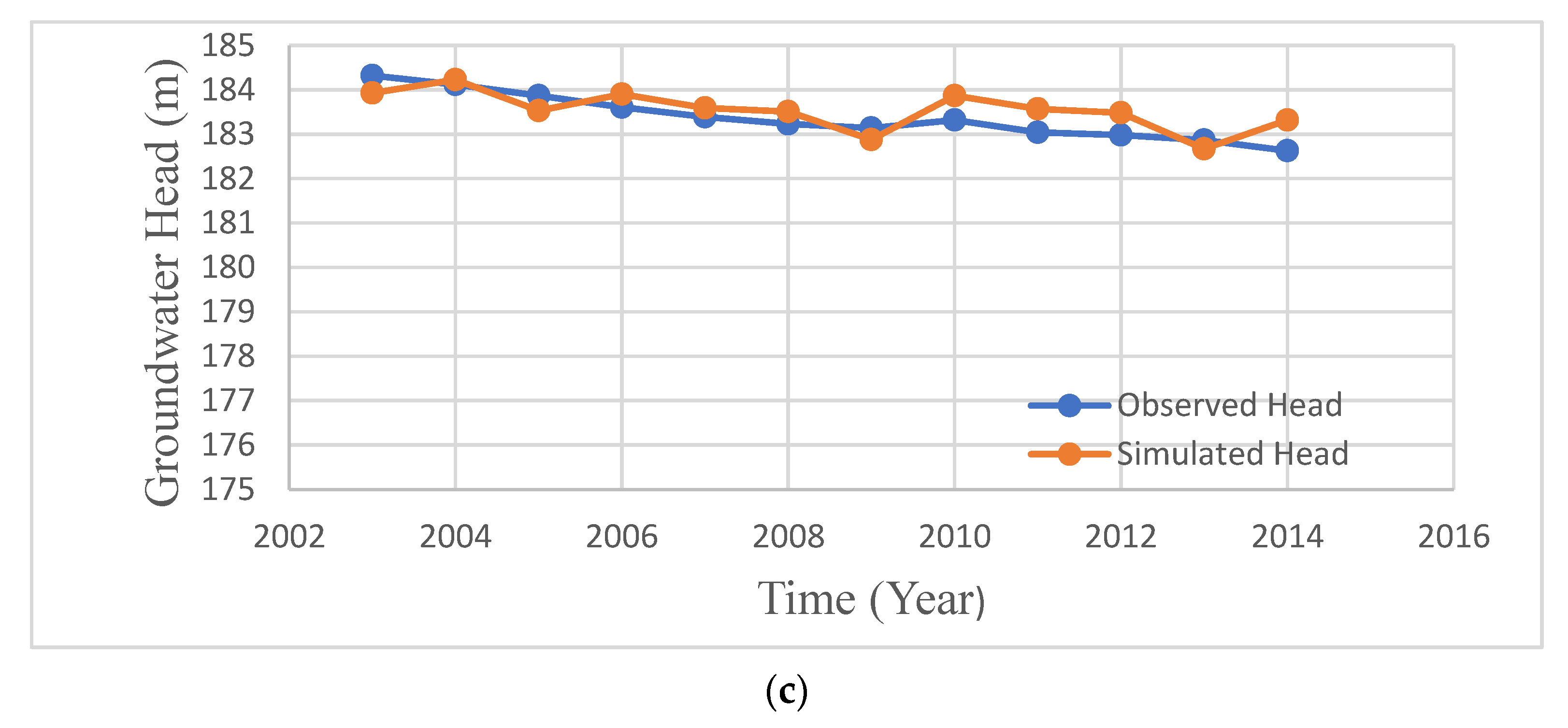
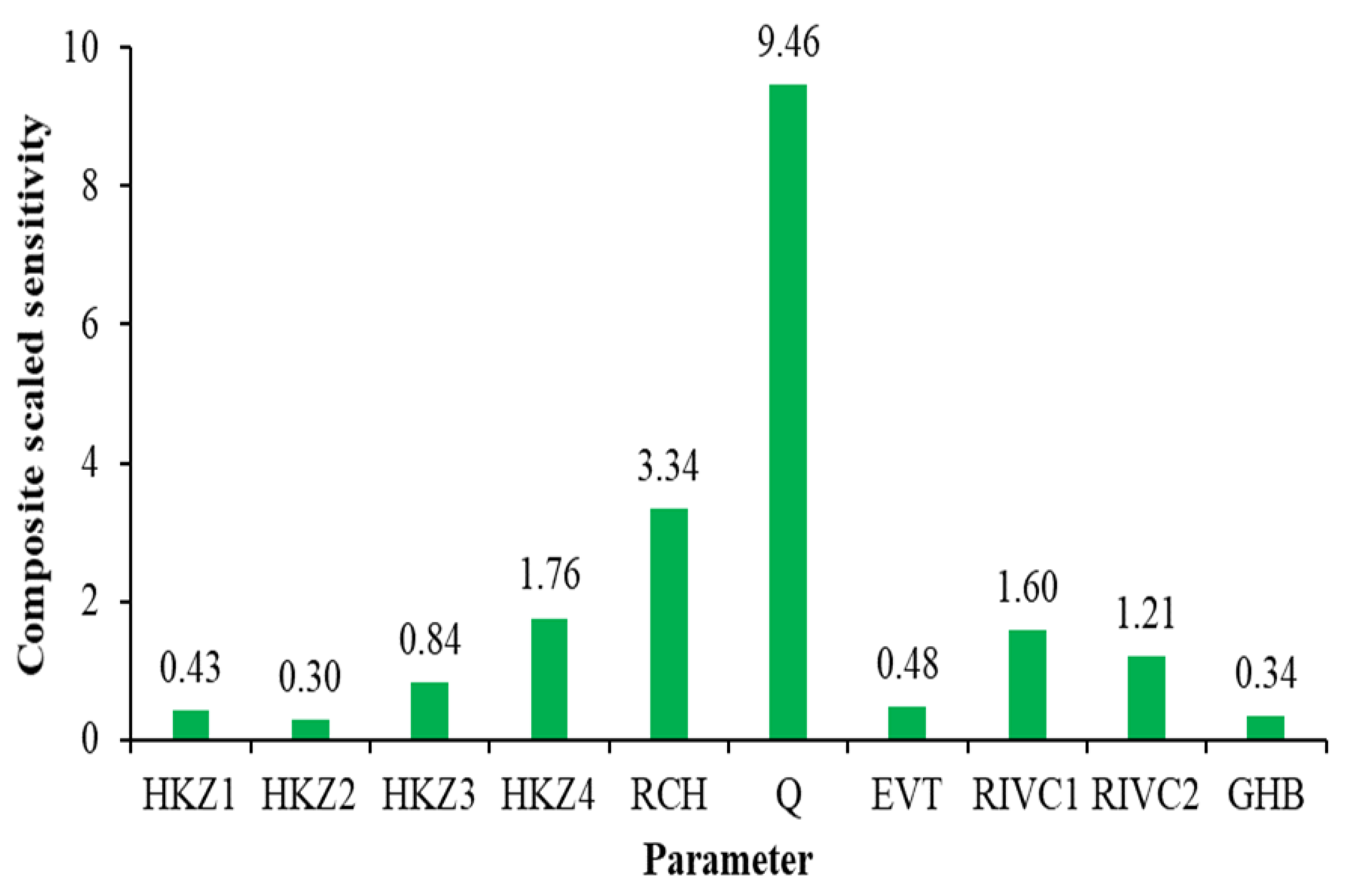

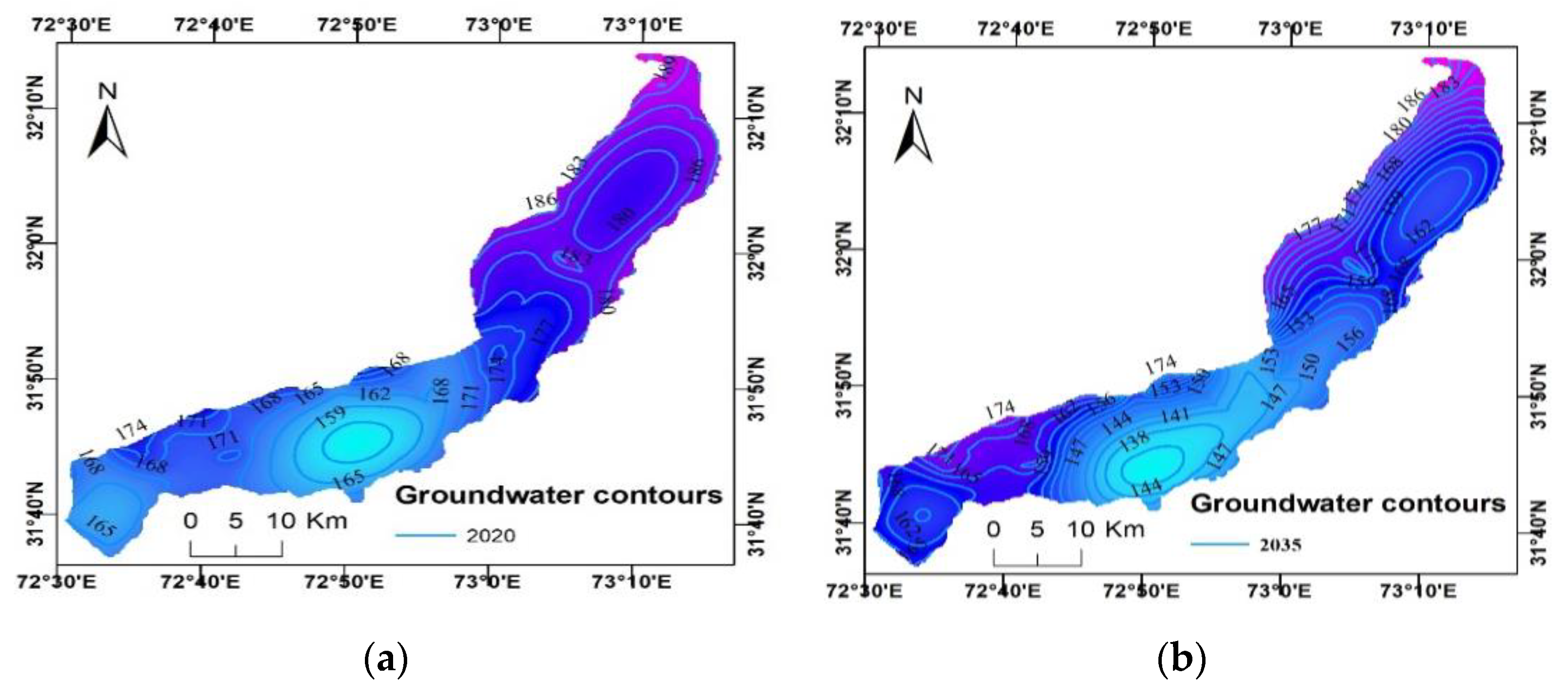
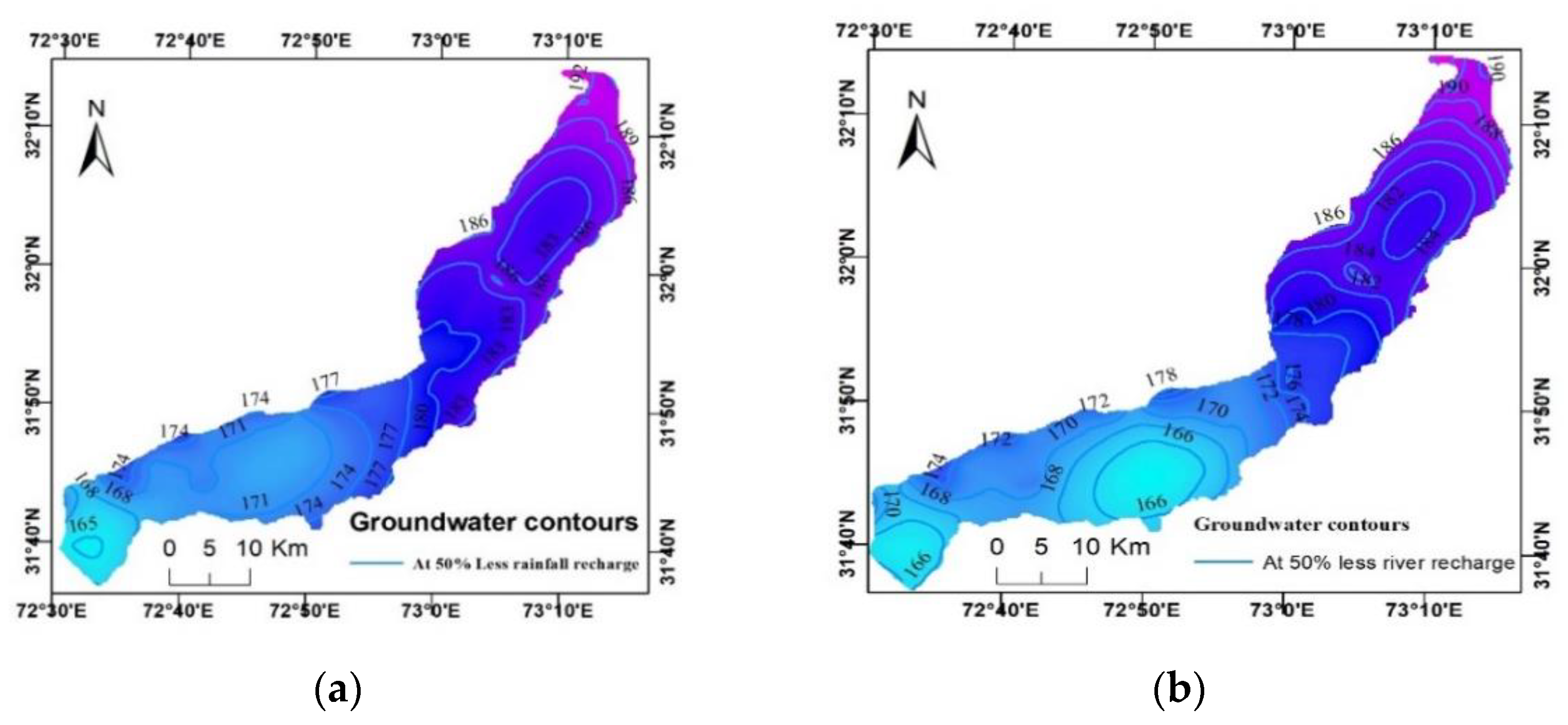
| Parameter | Value | Unit | Description |
|---|---|---|---|
| HKZ1 | 550 | m d−1 | Zone 1: Hydraulic conductivity |
| HKZ2 | 60 | m d−1 | Zone 2: Hydraulic conductivity |
| HKZ3 | 52.17 | m d−1 | Zone 3: Hydraulic conductivity |
| HKZ4 | 44.04 | m d−1 | Zone 4: Hydraulic conductivity |
| RCH | 0.95 R | mm d−1 | Groundwater recharge |
| Q | 1 | mm d−1 | Discharge rate |
| EVT | 1.1 ET | mm d−1 | Evapotranspiration |
| RIVC1 | 30 | m2 d−1 | Conductance of River Stream-1 |
| RIVC2 | 30 | m2 d−1 | Conductance of River Stream-2 |
| GHB | 10 | m2 d−1 | General head boundary conductance |
| Parameter | Formula | Values | |
|---|---|---|---|
| Calibration | Validation | ||
| Mean Error | –0.01836 | 0.102705 | |
| Mean Absolute Error | 0.5158 | 0.3162 | |
| Root Mean Square Error | 0.0022 | 0.0027 | |
| R2 | 0.98 | 0.99 | |
| Parameter | Inflow | Outflow | Inflow—Outflow | ||
|---|---|---|---|---|---|
| m3 day−1 | % | m3 day−1 | % | m3 day−1 | |
| GHB Boundary | 653,060.9 | 29.45 | 74,174.36 | 3.35 | 578,886.5 |
| River | 1,216,020 | 54.84 | 154,223.5 | 6.96 | 1,061,797 |
| Recharge | 348,247.3 | 15.71 | 0 | 0 | 348,247.3 |
| Evapotranspiration | 0 | 0 | 53,563.36 | 2.42 | −53,563.36 |
| Wells | 0 | 0 | 1,935,358 | 87.28 | −1,935,358 |
| Total | 2,217,329 | 100 | 2,217,329 | 100 | 0 |
| Scenarios | Pumping Wells | Inflow Through GHB Boundary | Outflow Through GHB Boundary | Discharge from Aquifer to River | Aquifer Recharge from Rivers | Aquifer Recharge from Precipitation | Evapotranspiration | Groundwater Level | |
|---|---|---|---|---|---|---|---|---|---|
| ×104 m3/day | M | ||||||||
| Reference | −194.98 | 64.41 | −6.8 | −15.37 | 120.99 | 36.49 | −4.79 | 0 | |
| I | I-A | −291.5 | 107.63 | −2.26 | −10.01 | 161.38 | 36.49 | −1.74 | −5 |
| I-B | −344.13 | 140.1 | −1.33 | −8.23 | 178.41 | 36.49 | −1.31 | −9.8 | |
| I-C | −390.46 | 173 | −0.83 | −6.99 | 189.81 | 36.49 | −1.01 | −14.6 | |
| I-D | −426.26 | 200.67 | −0.56 | −6.24 | 196.75 | 36.49 | −0.85 | −18.1 | |
| II | II-A | −245.88 | 84.28 | −4.02 | −12.16 | 143.72 | 36.49 | −2.43 | −2 |
| II-B | −294.79 | 109.52 | −2.19 | −9.89 | 162.56 | 36.49 | −1.71 | −5.3 | |
| II-C | −344.02 | 140.03 | −1.33 | −8.24 | 178.38 | 36.49 | −1.33 | −9.8 | |
| II-D | −387.66 | 170.87 | −0.86 | −7.06 | 189.24 | 36.49 | −1.03 | −14.3 | |
| III | III-A | −196.69 | 73.95 | −4.94 | −13.42 | 106.9 | 36.49 | −2.29 | −2.4 |
| III-B | −196.72 | 71.52 | −5.63 | −14.15 | 130.43 | 18.24 | −3.69 | −0.7 | |
Publisher’s Note: MDPI stays neutral with regard to jurisdictional claims in published maps and institutional affiliations. |
© 2022 by the authors. Licensee MDPI, Basel, Switzerland. This article is an open access article distributed under the terms and conditions of the Creative Commons Attribution (CC BY) license (https://creativecommons.org/licenses/by/4.0/).
Share and Cite
Aslam, M.; Arshad, M.; Singh, V.P.; Shahid, M.A. Hydrological Modeling of Aquifer’s Recharge and Discharge Potential by Coupling WetSpass and MODFLOW for the Chaj Doab, Pakistan. Sustainability 2022, 14, 4421. https://doi.org/10.3390/su14084421
Aslam M, Arshad M, Singh VP, Shahid MA. Hydrological Modeling of Aquifer’s Recharge and Discharge Potential by Coupling WetSpass and MODFLOW for the Chaj Doab, Pakistan. Sustainability. 2022; 14(8):4421. https://doi.org/10.3390/su14084421
Chicago/Turabian StyleAslam, Muhammad, Muhammad Arshad, Vijay P. Singh, and Muhammad Adnan Shahid. 2022. "Hydrological Modeling of Aquifer’s Recharge and Discharge Potential by Coupling WetSpass and MODFLOW for the Chaj Doab, Pakistan" Sustainability 14, no. 8: 4421. https://doi.org/10.3390/su14084421
APA StyleAslam, M., Arshad, M., Singh, V. P., & Shahid, M. A. (2022). Hydrological Modeling of Aquifer’s Recharge and Discharge Potential by Coupling WetSpass and MODFLOW for the Chaj Doab, Pakistan. Sustainability, 14(8), 4421. https://doi.org/10.3390/su14084421







